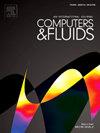Characterization of atmospheric and wind farm turbulence
IF 2.5
3区 工程技术
Q3 COMPUTER SCIENCE, INTERDISCIPLINARY APPLICATIONS
引用次数: 0
Abstract
Developing and assessing subgrid-scale models for characterizing atmospheric and wind farm turbulence is one of the key research areas within the wind energy community. This article presents the interaction of atmospheric and wind farm turbulence using scale-adaptive large-eddy simulation. Atmospheric turbulence has been incorporated by employing the stochastic forcing method to linearized Navier–Stokes equations, which interacted with a staggered cluster of utility-scale 41 wind turbines. The effect of atmospheric turbulence on wind turbine wakes was characterized by comparing scale-adaptive large-eddy simulation results with three reference data obtained from three other subgrid-scale models: Smagorinsky model, Deardorff’s one-equation turbulence kinetic energy model, and dynamic Deardorff model. The results suggest that vortex-stretching and strain skewness can accelerate wake recovery because scale-adaptive large-eddy simulation captured more than 90% of the turbulence kinetic energy, outperforming the other three models. The atmospheric turbulence in a wind farm has been characterized by considering mean vertical profiles, wake recovery, turbulence statistics, wavelet energy spectra, and power production. Finally, the interaction between atmospheric turbulence and wind turbines was evaluated through joint probability distribution of the second and the third invariant of velocity gradient and strain rate tensors and that of vortex-stretching and strain skewness. The results highlight the importance of considering vortex-stretching and strain skewness in turbine design, siting decisions, and wind farm layout optimization.
大气和风电场湍流特性
开发和评估用于表征大气和风电场湍流的亚电网尺度模型是风能界的关键研究领域之一。本文采用尺度自适应大涡模拟方法研究了大气湍流与风电场湍流的相互作用。大气湍流通过采用随机强迫方法纳入线性化的Navier-Stokes方程,该方程与交错的公用事业规模41风力涡轮机群相互作用。通过将尺度自适应大涡模拟结果与Smagorinsky模型、Deardorff单方程湍流动能模型和动态Deardorff模型的参考数据进行对比,表征了大气湍流对风力机尾迹的影响。结果表明,涡旋拉伸和应变偏度可以加速尾迹恢复,因为尺度自适应大涡模拟捕获了90%以上的湍流动能,优于其他三种模型。考虑了平均垂直剖面、尾迹恢复、湍流统计、小波能谱和功率产生等因素,对风电场的大气湍流进行了表征。最后,通过风速梯度和应变率张量的第二、第三不变量以及涡张量和应变偏度不变量的联合概率分布,评估了大气湍流与风力机的相互作用。研究结果强调了在涡轮机设计、选址决策和风电场布局优化中考虑旋涡拉伸和应变偏度的重要性。
本文章由计算机程序翻译,如有差异,请以英文原文为准。
求助全文
约1分钟内获得全文
求助全文
来源期刊

Computers & Fluids
物理-计算机:跨学科应用
CiteScore
5.30
自引率
7.10%
发文量
242
审稿时长
10.8 months
期刊介绍:
Computers & Fluids is multidisciplinary. The term ''fluid'' is interpreted in the broadest sense. Hydro- and aerodynamics, high-speed and physical gas dynamics, turbulence and flow stability, multiphase flow, rheology, tribology and fluid-structure interaction are all of interest, provided that computer technique plays a significant role in the associated studies or design methodology.
 求助内容:
求助内容: 应助结果提醒方式:
应助结果提醒方式:


